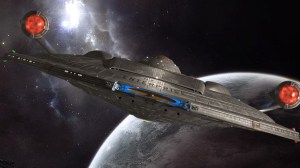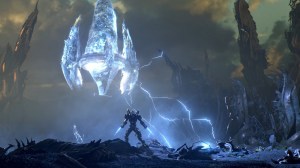WildC.A.T.s #1 and Writing Like Someone Else

“WildC.A.T.s” #1 is written by Jim Lee and Brandon Choi. Both of them love Chris Claremont’s writing style dearly, because they borrow heavily from it here, except it’s much more leaden.
Videos by ComicBook.com
Say what you will about Claremont, but his prose in those classic “Uncanny X-Men” issues had a lilt to it. It flowed smoothly. It felt natural. It could be flowery sometimes, but it rarely sat dead on the page.
That’s what’s missing here. You can ape someone’s style, but it will still lack that person’s unique point of view, sound, and/or rhythm. That will doom the attempt.
I can’t blame Jim Lee, who spent most of his professional career at that point working with Claremont, for picking up on those traits. Plus, if you’re going to mimic someone, it might as well be the best selling superhero comic writer of the time.
But it leads to clunkers like any time Void speaks. I’m all for Shakepearian language, but there’s some combination of vagueness and insipidness that makes me grind my teeth.
“Such are the portents of my dream, Marlowe. The visions reveal time lines merging at a crucial nexus very soon.”
Or:
“I am locked in mortal combat with a mysterious man, who covets an orb of great power. I believe this orb is a conduit for a kind of cosmic energy beyond our wildest imaginings…”
This feels like a good spot to insert an animated gif from Mortal Kombat. I’ll leave that as an exercise for the reader.
The dialogue is a bunch of vaguely “cool” words strung together to set up a plot, but the fact that the whole storyline rests on “an orb” is either Lee and Choi being Tarantino-esque years ahead of “Pulp Fiction”‘s glowing suitcase, or a vaguely thought-out plot that needed a second draft.
It’s also possible that Void is the WildC.A.T.s version of Claremont’s astral plane, an ethereal world where the rules of science don’t count for much and anything can happen that the writer wishes. I don’t like the astral plane very much, either.
The Two Big Problems
First, the issue gets too caught up in its own mythology and coolness. Yes, it’s exciting to set up an alien war and a government secret spy agency in first issue, while introducing at least a dozen new characters who will have major things to do at the beginning of the series.
Second, and because of that, the script sends the book off into too many different directions. You can never lock onto one character or situation for longer than a page or two before being whisked away to something else that’s not immediately connected. It’s confusing and headache-inducing.
Sometimes, comics are better off when they go a little slower, explain things more clearly, and leave room for surprise instead of confusion.
Not That It’s a Lost Cause
The good news with all of this, though, is that at least they had an idea of what they were doing. There was an attempt to tell a story with characters who have a point. There’s more going on here than just an attempt to be cool. That’s all in service to a story.
It often feels confused and distracted, but it’s there at the heart of it all.
Combine that with the excitement of the early Image days and the halo effect of Jim Lee’s X-Men run (which, honestly, suffered in his last few issues there), and you had an exciting and colorful launch.

The character designs are Peak Jim Lee, and could stand to be calmed down just a tad in many circumstances. In other ways, it’s all the cool bits and pieces you love to see him draw. I love Spartan’s pouches and Maul’s general shape. Grifter’s mask and hair is a unique combination. And Emp’s Jack Kirby-ness is a fun touch.
And, of course, there’s all that armor in various configurations that people like to fight in.
Jim Lee’s art is Jim Lee’s art, so that’ll sell plenty of books. I don’t think it’s his best stuff, even up to that point, but it’s exciting and filled with new characters, so we can enjoy it, anyway. (Scott Williams is inking, with Joe Rosas on colors.)
This is a stage in Lee’s art where he really fell in love with throwing extra lines in for “shading” and, uhm, connecting random muscles together. It gets really distracting in the second issue in the cheekbone areas, where half of some faces are filled with weird crosshatching for no reason.
The one thing you just don’t see anymore, but is present in these two issues, is the sideways page. I’m a sucker for sideways pages, but that was a technique that annoyed as many people as it thrilled. It didn’t last terribly long as a storytelling choice..
Lee sprinkles them throughout the first story arc, including a big double page sideways spread at the end of this first issue that should have just been a regular splash page.
I may have been the only one, but I cheered when, years later, he drew “Max Faraday” as a sideways comic.
The first issue ends with a memorable bang that would make Brian K. Vaughan jealous: Dan Quayle is actually possessed by an evil alien being! Millennials, ask your parents, particularly when Maul calls him a “potato head” later in the story arc.
Of Colors and Covers

Of all the cover gimmicks of the early 90s, “WildC.A.T.s” #2 had one of the best. It fit in perfectly with Void’s look. It’s right up there with the glow-in-the-dark flames of “Ghost Rider” #15’s cover in that way. The little dizzying circles of silver can mesmerize you every time you glance at them.
My scan of the cover can’t do it justice, but that cover shines.
One of the highlights of the first issue, for me, was the coloring of Joe Rosa. His color palette is very light, very desaturated. He concentrates a bit on the shadows on skin, where he gets to pull off a slightly pinker shadow than usual. There are a few gradients and airbrush type effects, but your eye barely registers them. Instead, you feel the shadow different more than you see it. It just is.
Joe Chiodo took over the coloring with the second issue and the difference is dramatic. Colors became deeper and darker. Rosas’s lighter colors showed off the art better, but didn’t have the “Golly Gee Wow” pop that Chiodo’s more complex coloring did.
I loved Rosas’ more restrained touch. Look at the cover to the first issue. By today’s standards, it looks like it never got past the flatting stage, yet it’s filled with subtle gradations and shadow work. I love, in particular, the special effect of Maul’s head fading out a bit, as if the Image “i” logo in the corner is made of glass or something.
25 Years Later…
As we celebrate Image’s 25th anniversary, it’s fun to see how far we’ve come.
For starters, the initials are gone from this property’s name. They prefer “Wildcats” now.
WildStorm doesn’t really exist at the moment. Warren Ellis is rebooting the concept shortly over at DC, who Jim Lee sold out to in less than ten years.
The second issue of WildC.A.T.s was delayed due to the birth of Lee’s first child, who by now is a full-grown adult. (Feel old now?!?) He wasn’t the only one with delays in the early days of Image due to family matters. Erik Larsen released the first issue of “Savage Dragon” and then got married, delaying issue #2 there, as well.
Such is life.
For more on the glory days of WildStorm, I have to point you to this Kickstarter. It only has a couple days left as of this writing, and it’s called “Wild Times: An Oral History of Wildstorm Studios.” It looks awesome.
I’ll continue this look back at the first issues of Image Comics next week…
And join me at PipelineComics.com for more on Image’s 25th anniversary, including more on WildC.A.T.s. in the days ahead…
PipelineComics.com|| Twitter || Instagram || E-mail








